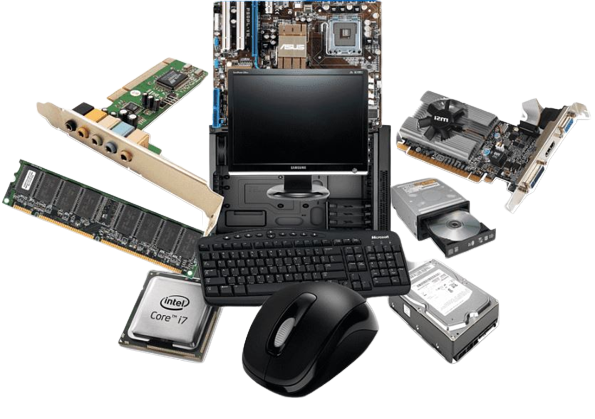
Computer hardware refers to all physical components that make up a computer system, from input devices like keyboard and mouse, monitor, printer and external storage to output devices such as monitor, printer and external storage.
The keyboard allows users to input data into a computer using alphanumeric and special keys. Each key provides its own specific command depending on which software application is being used.
Motherboard
A motherboard (also referred to as a system board or baseboard) serves as the heart of any computer, linking its CPU, memory modules, hard drives and expansion cards directly or via cables.
A motherboard contains circuit technology to coordinate computer processes and a heat sink to collect and redirect heat during usage. Additionally, there are USB ports and a CMOS battery available as backup power sources.
CPU
Modern computers use billions of micro transistors to perform amazing feats like creating TikTok videos and processing spreadsheets – but all they do in reality is interpret currents of electricity into binary signals of 1s and 0s.
The Central Processing Unit has a control unit which decodes instructions and transmits them to other circuits such as an arithmetic logic unit. Furthermore, it serves as a data gateway between primary and secondary memory.
RAM
RAM (random access memory) is the central memory space in a computer and stores information that the CPU can quickly access.
RAM differs from ROM in that its contents can be lost if power goes out; however, RAM’s speedy data processing capabilities make it much quicker than a hard disk drive.
SRAM uses transistors that store memory as long as they receive even a trickle of power, while DRAM relies on capacitors which must be “refreshed” with large bursts of energy periodically – both are offered in SIMM and RIMM packages for greater convenience.
Mouse
Mouse is a handheld hardware input device for controlling cursor movement on computer screens. It consists of a body that fits your hand and travels along hard flat surfaces with ease while its tail connects directly to the computer via electrical cable.
The mouse tail contains one to three buttons that serve as external contacts for small electrical switches. By clicking, these switches close and send a signal directly to its integrated circuit interface.
Keyboard
A keyboard is a computer hardware device used for entering letters, numbers and other symbols onto your computer screen. It contains various sets of keys arranged into sets called alphanumeric keys which enable you to type letters alphabetically; numeric keys arranged like those found on calculators and adding machines; as well as function keys which provide specific commands depending on which program you are running.
Keyboards come either wirelessly or wired and usually connect directly to the motherboard of a computer.
Monitor
Monitors interpret and display graphic output signals from computers onto screens, often known as VDU (visual display unit).
Modern monitors utilize flat panel display technology. These monitors require less desk space and energy efficiency compared to older CRT monitors, and come in various sizes and resolutions – the best ones often offer outstanding contrast ratio and refresh rate performance.
Network Interface Cards (NICs)
Network Interface Cards (NICs) enable computers to communicate across networks by providing both physical layer and data link layer communication services, whether using wires or Wi-Fi connections. They’re typically used with wired connections but wireless options also exist.
The Network Interface Card, or NIC, is a circuit board that connects directly to your motherboard or can be placed into expansion slots and converts electrical impulses into information your computer can display on-screen.
Hard Drive
Hard disk drives store digital data on flat, circular platters. Because the data remains on these drives even when power is removed from them, hard drives are popularly found in laptops, desktop computers and external storage devices.
Each platter features an electromagnetic surface containing hundreds of tiny electrical charges that accept electrical charges representing binary code of 1s and 0s. A read/write head can then retrieve this data by magnetically altering its surface.
Scanner
A scanner is an input device that uses light-sensor technology to convert physical documents and photos into digital files. When combined with computer software, scanners allow for efficient management and importation of scanned information into systems.
Scanners are invaluable tools for businesses that need to digitize important papers and documentation, or conducting research that involves accessing borrowed library books for information gathering.
Printer
Printers are physical output devices used to transfer computer-generated electronic data in printed form – be it text files, pictures or a combination thereof.
Computer technicians specialize in diagnosing printer issues, from verifying power is running to the device to replacing or refilling ink cartridges. Printers rely on special system software known as drivers to communicate with computers.




